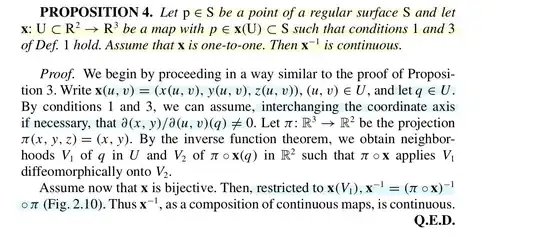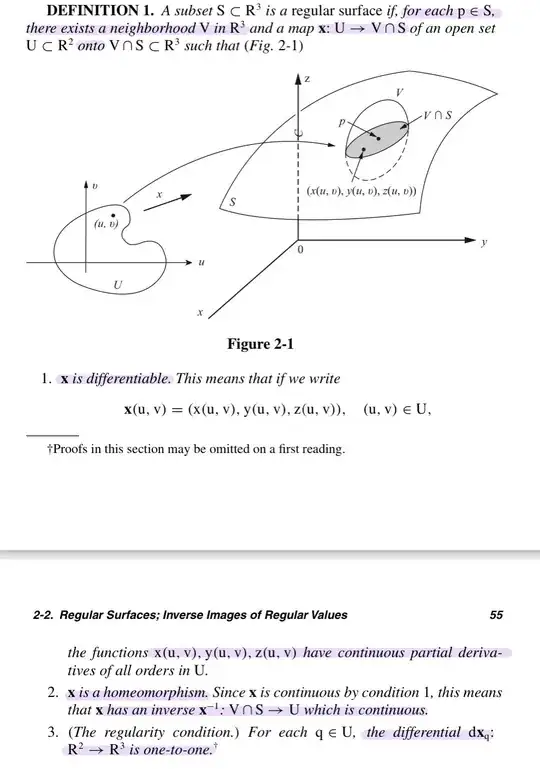I am reading De Carmo's DG of curves and surfaces. But I have some questions on the proof of "a local parametrization of a regular surface is automatically open", the exact statement is attached below by pic. I am wondering when the condition that S is regular is used in the proof, it seems to me that the proof only uses the conditions of x
- 1,457
-
1Your question makes no sense to me. All the definition is about $\mathbf x$. He applies the inverse function theorem to deduce openness, and this uses precisely the regularity condition. – Ted Shifrin Oct 14 '21 at 16:13
-
@Ted Shifrin, It's not that simple, if this proof was actually correct we could apply it to the figure 8 or a surface analogue of that which can be obtained by extending the figure 8 in the z direction, these are not embeded manifolds in R^2 or R^3 respectively. If this proof was actually correct those examples wouldnt exist. – wannabecapablanca Feb 25 '24 at 15:09
1 Answers
Indeed he never used that $\mathrm{S}$ is a surface, which is why this proof is indeed wrong (or incomplete), a rare oversight by Manfredo. Note that he concluded that $\mathrm{x^{-1}}$ is continuos when restricted to $\mathrm{x(V_1)}$, but we do not know that this set is open, so it isnt possible to conclude from this that $\mathrm{x^{-1}}$ is continuous in the full domain $\mathrm{x(U)}$.
The proof can be amended by actually using the full hypothesys:
Since $\mathrm{S}$ is a surface, we can find a neighborhood $\mathrm{V_0}$ of $\mathrm{p}$ that is the graph of a differentiable function over the projection onto one of the coordinate planes, for simplicity let us assume that $z=f(x,y)$ in this neighborhood (other cases are analogous). From this we see that the projection $\mathrm{\pi:V_0 \to \pi(V_0)}$ is an homeomorphism.
Now for $q=(u,v)\in \mathbf{x}^{-1}(V_0)=:U_0$ we have $\mathbf{x}(u,v)=(x(u,v),y(u,v), f(x(u,v),y(u,v)))$ and by the injectivity of $\mathrm{d\mathbf{x}_q}$ we conclude that $\partial(x,y)/\partial (u,v) \neq 0$.
At this point we proceed like in Manfredo's proof. By the inverse function theorem, we obtain neighborhoods $V_1$ of $q$ in $U_0$ and $V_2$ of $\pi\circ\mathbf{x}(q)$ such that $\pi\circ\mathbf{x}$ applies $V_1$ diffeomorfically onto $V_2$. So, restricted to $\mathbf{x}(V_1)$ we have that $\mathbf{x}^{-1}=(\pi\circ\mathbf{x})^{-1}\circ \pi$ is continuous.
Now the key point is that since $V_2=\pi\circ\mathbf{x}(V_1)$ is open and $\mathbf{x}(V1)\subset V_0$, by the above observation that $\mathrm{\pi:V_0 \to \pi(V_0)}$ is an homeomorphism we conclude that $\mathbf{x}(V1)$ is open, which concludes the proof.
$\square$
In short, the mistake in the original proof can be seem as an implicit misuse of the gluing lemma.
